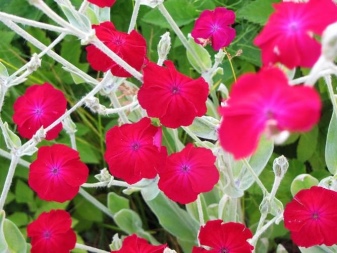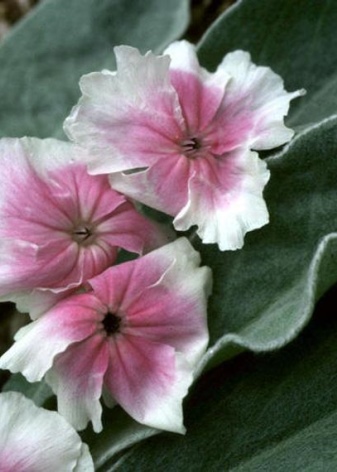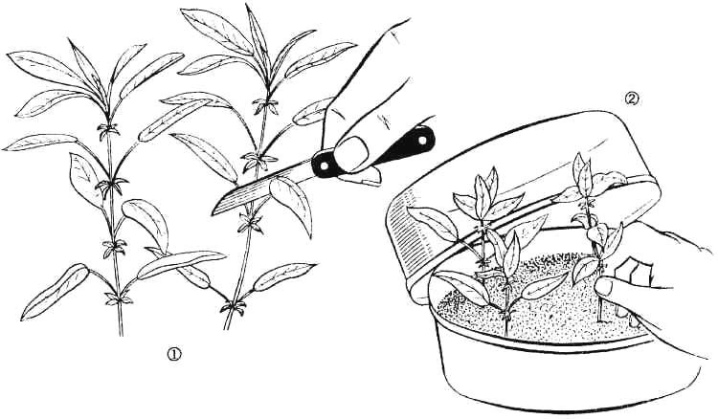Lychnis crown: planting, care, breeding

Lychnis is a culture that has long been known to flower growers, because its beautiful fiery red flowers are visible from afar. The most popular is chalcedony lychnis or dawn, but, unfortunately, few know about such a form as crown. Nevertheless, this plant has no less advantages. Like its relative, it is able to beautifully decorate the garden, bringing novelty and freshness to it.
Description
Likhnis crown belongs to the clove family and is a perennial, but in many regions of Russia it is grown for no more than two years. Lychnis grows up to 1 meter in height, but its bush branches well in different directions. The leaves of the shrub are medium, in the shape of an oval, of an unusual silvery-green color, which is the "calling card" of the species. The same can be said about the stems of the culture, which also have a spectacular silver coating.



As for the flowers, they are round, each has 5 petals, which, fading, fall to the ground. The colors are completely different: there are snow-white specimens, flowers of raspberry, red, burgundy colors. Two-tone flowers are very popular, resulting from the recent work of breeders. Flowering starts in June and ends in November.
All this time, the flowering is abundant and beautiful, which will surely delight gardeners who love to decorate the site.


Varieties
Consider several of the most famous varieties of the described culture.
- Angels Blush. A low, very interesting variety that reaches 60 centimeters in height. It has a unique feature: initially, its flowers are white, and then they begin to turn pink as they bloom. The disadvantage of this variety is that you cannot predict the quality of the seeds. Many gardeners say that they bought seed, which gave faded, not too beautiful bushes.


- Atrosanguinea. This variety grows up to a meter in height, has pubescent, silvery-green leaves. It blooms very beautifully, bright red inflorescences will attract bees and butterflies from all over the area. It is practically undemanding to soil and air temperature.


- "Mysterious Island"... A perennial variety with an interesting name and small flowers. Their colors can be reddish, crimson, pink. Like the previous variety, it does not require active care, it resists cold well.


How to plant?
When preparing to plant a plant in open ground, you need to responsibly approach the choice of a planting site. The plant will like open places with a lot of sun, partial shade or shade will not work - in such conditions, flowering will be scarce. Drafts do not play a role - unlike most horticultural crops, lychnis is not afraid of the wind. The plant also excelled in soil requirements. If the soil is too fertile, then lychnis will acquire a large amount of green mass, but there will be few buds. Therefore, a light, aerated soil is needed.
The soil is prepared a month before planting. The site is dug up by adding humus, sand or superphosphate to the soil. In this form, the earth is left so that the fertilizing can be processed. When a month has passed, you can start disembarking. Small holes are made in the soil, and then drainage is covered with a thin layer, for example, pebbles, gravel, bricks. From above, the drainage is covered with soil, and then the plant is lowered and covered with earth, making sure that the roots are completely covered.Having finished these manipulations, the earth is compacted and well watered.



Reproduction
Lychnis crown can be propagated using two main methods, each of which has its own timing and advantages.
Seeds
Interestingly, the culture is able to reproduce even without the help of a gardener. This is called self seeding. The seeds dropped from the plant go deep into the ground and hibernate there in natural conditions in order to give healthy shoots in the spring. All that remains for the gardener is to choose the tallest specimens and plant them.


However, in some cases, summer residents sow seeds on their own. They do this in April, when the threat of freezing has passed. The air temperature should fluctuate between 18-21 degrees Celsius. The seed is placed in open ground, crushing it slightly with earth. If, before this, the planting material has not passed the stratification procedure, you can cover the bed with polyethylene. After 21 days, the first shoots will appear, which then need to be dived.
In addition to planting in open ground, you can sow seeds for seedlings. In the last days of January, planting material is placed in the refrigerator for a month, and then planted in containers with light soil and covered, not forgetting to air it daily.
In this case, the temperature should be at least +20 degrees, and the crops will have to be moistened with a spray bottle. Seedlings are planted in open ground in the summer.



By cuttings
Lychnis can be propagated by cuttings. To do this, in June, you need to select shoots from strong plants, at least 15 cm. The sections on the mother bushes are treated with garden pitch or crushed coal. The resulting shoots are placed in drained soil, watered well. Such bushes need to be planted in a permanent place in the fall. Cutting is a less popular method of propagation, although you can find gardeners who prefer it, but the seed path is still more effective.

Follow-up care
It is not at all difficult to care for lichnis in the open field, you just need to remember a few rules.
Watering
Lychnis crown does not require frequent watering, the only exception is an overly hot summer without rain. If it is not hot outside, then it is watered once a week, you will need about a bucket of settled water. You need to water so that the liquid does not get on the flowers and leaves. In the rainy season, you can do without watering altogether.
Remember that excessive moisture will be bad for crop health.

Top dressing
As mentioned above, only infertile soil is suitable for crown lichen. For this reason, flowering must be stimulated with top dressing. Fertilize twice: before flowering and during it. Top dressing before flowering is prepared as follows: take a tablespoon of carbamide, potassium sulfate and superphosphate, dilute in a bucket of water. A flowering feed includes Agricola fertilizer and superphosphate, each tablespoon each. Diluted, as in the previous case, and then watered at the root.


Preparing for winter
Before wintering, the soil is well loosened, at the same time uprooting the weeds. The upper part of the plant is cut off completely, leaving a small stump. In general, it can be noted that the plant will cope well with cold weather, but this applies only to those regions where a lot of snow falls. If it is not enough or not at all, you need to cover the bushes with spruce branches. This rule is mandatory for terry varieties, regardless of the amount of snow.

Disease and pest control
It can be noted that lychnis adequately resists diseases, but its frequent problem is rotting of the root system. This is due to excessive watering. Rotting spreads quickly, resulting in fungus, rust, spotting. In this situation, you need to immediately adjust the watering and treat the plant with fungicides. If there is no result, diseased bushes will have to be removed from the ground and burned.
Of the pests, the most annoying pest for gardeners is the leafworm, which feeds on the juices of leaves and stems. You can destroy it with insecticides. In addition, aphids and spider mites, which parasitize on any crops, can cause considerable harm.
Initially, you can fight them with an infusion of soap or tobacco, but if this does not help, you will have to use insecticides.

Examples in landscape design
Likhnis crown, if properly planted, will ennoble and decorate any area. It can be successfully planted along the paths, decorated with benches, a fence. The culture looks beautiful as part of a flower bed or alpine slide. It looks no less elegant in single plantings, especially if several different varieties have been chosen. From other cultures, it can be combined with bells, daisies, primrose, carnations, violets, asters.

Consider several photo examples of the use of lyhnis on the site.
- Here, the culture is used as part of the flower bed, combining beautifully with contrasting daisies.

- An excellent solution for dry areas, can be planted alone or in combination with other hardy crops.

- You can beautifully decorate a fence, a wall of a house with bright red flowers, or simply plant them in any other place.

- Lychnis koronchaty in the design of paths and borders.



See below about the features of caring for lychnis.







































































































The comment was sent successfully.